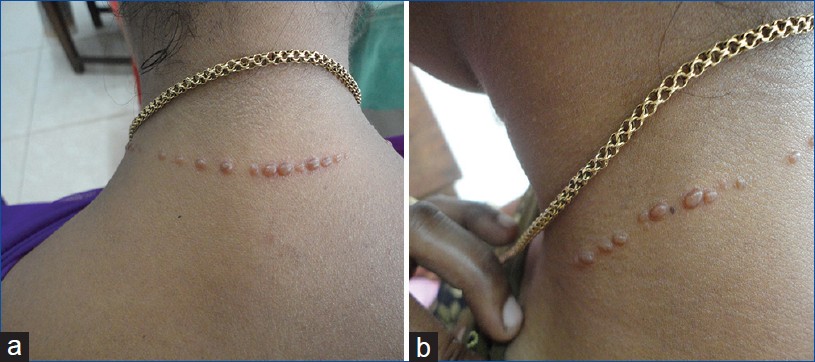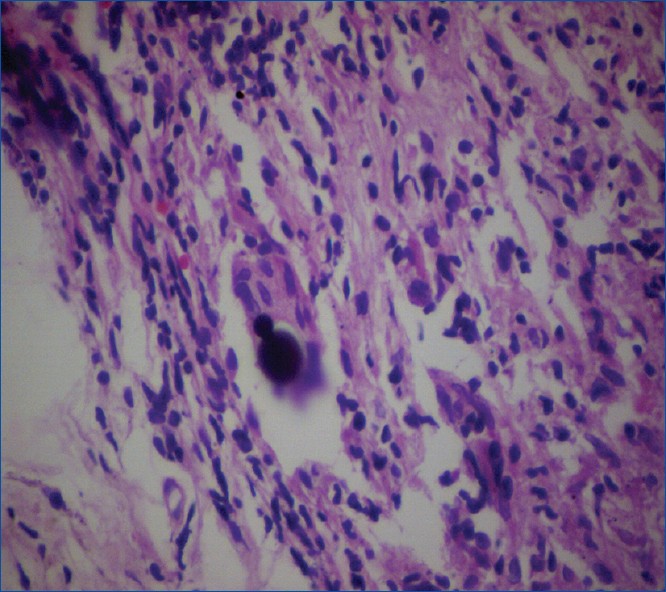Translate this page into:
Gold granuloma in a beaded pattern due to lightning strike: A unique presentation
2 Department of Pathology, Goverment Medical College, Calicut, India
Correspondence Address:
Rahima Saleem
Departments of Dermatology, Venereology and Leprosy, Goverment Medical College, Calicut
India
| How to cite this article: Saleem R, Riyaz N, Anupama MA. Gold granuloma in a beaded pattern due to lightning strike: A unique presentation. Indian J Dermatol Venereol Leprol 2013;79:430-431 |
Sir,
Lightning strikes are high-voltage electrical discharges caused by lightning. It can cause severe injuries in humans with a mortality of 10-30%. [1] Metallic objects in contact with the skin may concentrate the lightning strike, preventing flashover effects resulting in more serious injuries. Granulomas are an organized collection of epithelioid macrophages, formed to remove the substances which are foreign, but unable to eliminate. We report a rare case of lightning injury presenting as foreign body granuloma in a beaded pattern to the metals which was implanted during the strike.
A 26-year-old married woman presented with multiple asymptomatic shiny beaded papules over the neck since 10 years. Two years prior, she gave a history of lightning strike, due to which her dress and necklace had burnt off. She then had discrete charred areas corresponding to the beads of the gold necklace. On examination, there were multiple erythematous shiny beaded papules over the nape [Figure - 1]a and sides of the neck [Figure - 1]b. Histopathological examination revealed normal epidermis with well-defined epithelioid granulomas surrounded by a lymphocytic mantle [Figure - 2] and with multiple foreign body giant cells containing circular and oval black deposits and few vacuolar spaces on H and E stain [Figure - 3].There was no caseation and periodic acid schiff stain and Wade-Fite were negative. Serum angiotensin converting enzyme and serum calcium were normal. Under polarized light, there was no birefringence. She was treated with topical and intralesional steroids with good response.
 |
| Figure 1: (a) Beaded papules over the nape of the neck, (b) Beaded papules over the sides of the neck |
 |
| Figure 2: Granuloma with foreign body giant cell (H and E, × 40) |
 |
| Figure 3: Foreign body within a giant cell (H and E, × 40) |
Lightning strikes are high-voltage electric charges that choose shortest paths between the contact points of the human body involving vital structures in its pathway. In a direct hit, if the skin resistance is high, much of the current will flash around the skin or clothing to the ground, resulting in a benign outcome but metallic objects in contact with the skin may concentrate the lightning strike. [1] Our patient also had a direct hit and the maximum concentration was at the golden beaded necklace. Two cases have been reported in I pod users with maximum injury at the site of contact with I pod.There was also a case of destruction of hearing aid by the lightning strike. [2]
Lightning burns characteristically produce arborescent lesions known as Lichtenberg figures or fern-like pattern which is not a burn. It can also produce small linear burns at the site of metal objects as in our patient. In an analysis of 45 fatalities due to lightning strike, one-third had the typical arborization. [3] Granulomas are formed in response to an antigen that are resistant to the "first responder" inflammatory cells. In our patient, burnt gold particles acted as the inciting factor. These antigens activate macrophages and CD4 helper T lymphocytes and induce a TH1 type of immune response releasing cytokines and resulting in a granuloma formation. Histopathological examination in our patient revealed minimal epidermal change ruling out chromoblastomycosis. Also, there was no caseation and Wade-Fite was negative ruling out tuberculosis and leprosy. There was also a definite mantle of lymphocytes ruling out naked granuloma of sarcoidosis. There were no Schaumann bodies or asteroid bodies. The burnt metallic particles were seen as dark circular and oval-shaped particles in and around the giant cells and also seen as empty spaces due to elimination of the foreign body during processing. There was no mucin in the center ruling out granuloma annulare.
Polarization microscopy often gives a clue to the type of foreign body. Marcoval, et al. [4] reviewed foreign bodies in granulomatous cutaneous lesions of patients with systemic sarcoidosis and found that 14 of 65 patients with cutaneous sarcoidosis showed foreign particles in polarized light. Finding of polarizable foreign matter traditionally permits exclusion of the diagnosis of sarcoidosis. However, foreign particles were seen in certain sarcoid granulomas. Clinically, these cases had presented with papules and infiltration over the undetected minute scars similar to the infiltrated beaded papules over the previously charred areas as in our case. On histopathological examination, there was lymphocytic mantle which was not seen in cases described by Marcoval, et al. [4] Empty spaces in the vicinity of giant cells were also noted by them. Differentiation of a foreign body granuloma and sarcoidal granuloma is possible with polarized light microscopy and energy dispersive X-ray analysis. [5]
Scott et al. [5] also had noted an old man presenting with granulomatous reaction to gold dental alloy which was accidentally implanted and manifesting as pale nodules in the oral mucosa. Gold usually cause only a mild tissue reaction. Of the nine cases reported by Keen et al., [6] only one had granulomatous reaction. More common are non-specific eczematous, urticarial, lichenoid, or pityriasis rosea-like lesions. A florid granulomatous contact dermatitis to gold earrings has also been reported which was confirmed by patch testing with gold sodium thiosulfate. [7]
To conclude, we present a patient with foreign body granuloma probably gold induced in a beaded pattern as a sequelae of lightning strike. This case is a very unique manifestation of lightning strike which invokes us to know more about lightning injuries.
| 1. |
Ritenour AE, Morton MJ, McManus JG, Barillo DJ, Cancio LC. Lightning injury: A review. Burns 2008;34:585-94.
[Google Scholar]
|
| 2. |
Tandberg D, Brown CM. Destruction of hearing aid by lightning strike. Am J Emerg Med 1990;8:326-8.
[Google Scholar]
|
| 3. |
Wetli CV. Keraunopathology. An analysis of 45 fatalities. Am J Forensic Med Pathol 1996;17:89-98.
[Google Scholar]
|
| 4. |
Marcoval J, Mañá J, Moreno A, Gallego I, Fortuño Y, Peyrí J. Foreign bodies in granulomatous cutaneous lesions of patients with systemic sarcoidosis. Arch Dermatol 2001;137:427-30.
[Google Scholar]
|
| 5. |
Scott FR, Dhillon AP, Lewin JF, Flavell W, Laws IM. Gold granuloma after accidental implantation. J Clin Pathol 1995;48:1070-1.
[Google Scholar]
|
| 6. |
Keen CE, Brady K, Kirkham N, Levison DA. Gold in the dermis following chrysotherapy: Histopathology and microanalysis. Histopathology 1993;23:355-60.
[Google Scholar]
|
| 7. |
Armstrong DK, Walsh MY, Dawson JF. Granulomatous contact dermatitis due to gold earrings. Br J Dermatol 1997;136:776-8.
[Google Scholar]
|
Fulltext Views
2,687
PDF downloads
1,876





